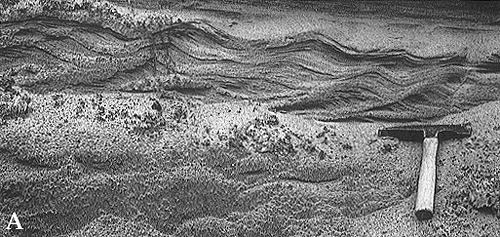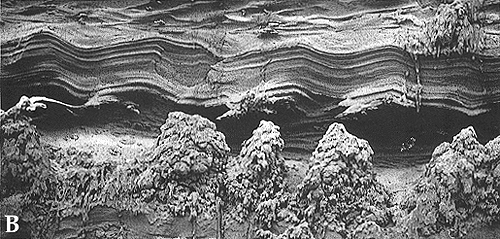

Climbing bed forms: truncated and sinusoidal ripples
Plate 55


Climbing bed forms: truncated and sinusoidal ripples
Plate 55
Let us now examine a situation where grain fallout takes the lead on tractive effects. With increasing rate of deposition, some sand and silt accumulate also on the stoss side of ripples, and backset laminae form (A). Their thickness increases as to equalize that of foreset laminae (B). Ripples keep on climbing, but the angle of climb becomes steeper. This means that the migration of bed forms decelerates, while the vertical accretion of the bed speeds up. The more balanced sediment deposition on the two sides of ripples reduces the asymmetry of their profile, which has been called sinusoidal. 1 Laminae associated with sinusoidal ripples are continuous and have a draping attitude; the term cross-lamination becomes improper at this stage, because there are no more erosional truncations. It might be called asymmetrical wavy lamination. On the other hand, this is the end member of a continuous spectrum of phenomena related to bed form migration and tractive lamination, which is centered on cross-lamination. Moreover, wavy lamination rarely occurs in separated beds; it usually grades into genuine cross-lamination, as these pictures show.
The outcrop is artificial and is found in a sand pit open in Pleistocene glacio-lacustrine deposits in Massachusetts. The sand was carried into lakes by short-headed streams fed by melt water.
Climbing bed forms originate mostly at small scale; examples of medium scale are found, although not frequently, among subaqueous dunes and pyroclastic dunelike forms (see color photo 15). Suitable conditions for generating larger forms are probably attained with more difficulty in comparison with ripple-generating suspensions. The scale, strength, and persistence of turbulent motion required for larger forms are rather exceptional (e.g., violent volcanic eruptions).
Note 1: A. V. Jopling and R. G. Walker. 1968. Morphology and origin of ripple-drift cross-lamination, with examples from Pleistocene of Massachusetts. J. Sed. Pet. 38: 971-984. Back.